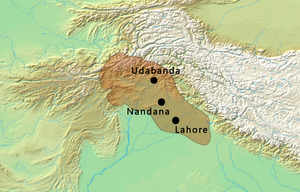
Back হিন্দু শাহী Bengali/Bangla Hinduixàhida Catalan Hindu-Shahi German شاهی هندو Persian हिन्दू शाही Hindi Shahi (regno) Italian हिन्दु शाही वंश Nepali ਹਿੰਦੂ ਸ਼ਾਹੀ Punjabi برہمن شاہی PNB هندوشاهي Pashto/Pushto
Hindu Shahis | |||||||||||
|---|---|---|---|---|---|---|---|---|---|---|---|
| c. 843 CE–1026 CE | |||||||||||
Location of the Hindu Shahis, and contemporary polities, c. 1000 | |||||||||||
| Capital |
| ||||||||||
| Religion | Hinduism | ||||||||||
| Government | Monarchy | ||||||||||
| Maharajadhiraja | |||||||||||
• c. 843 CE | Kallar | ||||||||||
• c. 850 CE | Samanta | ||||||||||
• c. 880 CE | Lalliya | ||||||||||
• c. 903 CE | Toramana | ||||||||||
• c. 921 CE | Bhimadeva | ||||||||||
• c. 964 CE | Jayapala | ||||||||||
• c. 1002 CE | Anandapal | ||||||||||
• c. 1010 CE | Trilocanapala | ||||||||||
• c. 1021 CE | Bhimapala | ||||||||||
| Historical era | Early Middle Ages | ||||||||||
• Established | c. 843 CE | ||||||||||
• Disestablished | 1026 CE | ||||||||||
| |||||||||||
| Today part of | Afghanistan Pakistan India | ||||||||||
The Hindu Shahis (843–1026 CE)[2] were a dynasty that had usurped power from the earlier Turk Shahis in the 9th century. The Hindu Shahis core territory is described as having been based in the regions of Eastern Afghanistan and Gandhara, encompassing the area up to the Sutlej river in modern day Punjab. The territorial zenith occurred under Jayapala in which the Shahi doman stretched from Lamghan and bordered Multan and Kashmir, extending to Lahore in the West.[3] The empire was founded by Kallar in c. 843 CE after overthrowing Lagaturman, the last Turk Shahi king.
- ^ Schwartzberg, Joseph E. (1978). A Historical atlas of South Asia. Chicago: University of Chicago Press. p. 146, map XIV.2 (j). ISBN 0226742210.
- ^ The Last Two Dynasties of The Shāhis. 1976. p. 47.
- ^ The Last Two Dynasties of The Shāhis. 1976. p. 1.
© MMXXIII Rich X Search. We shall prevail. All rights reserved. Rich X Search

